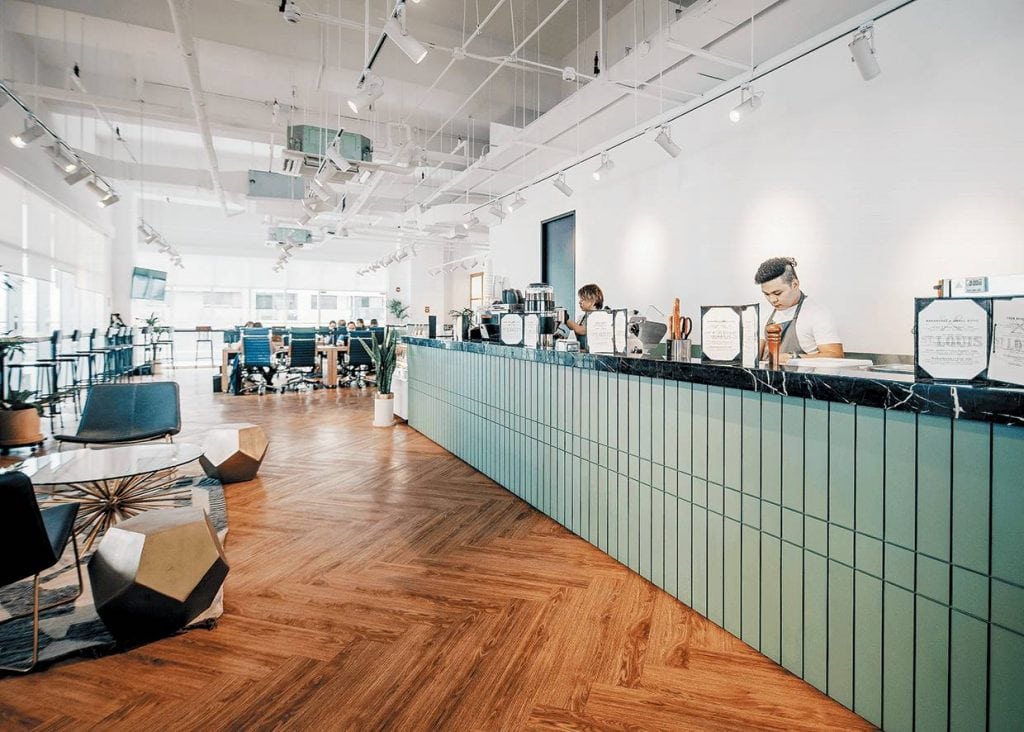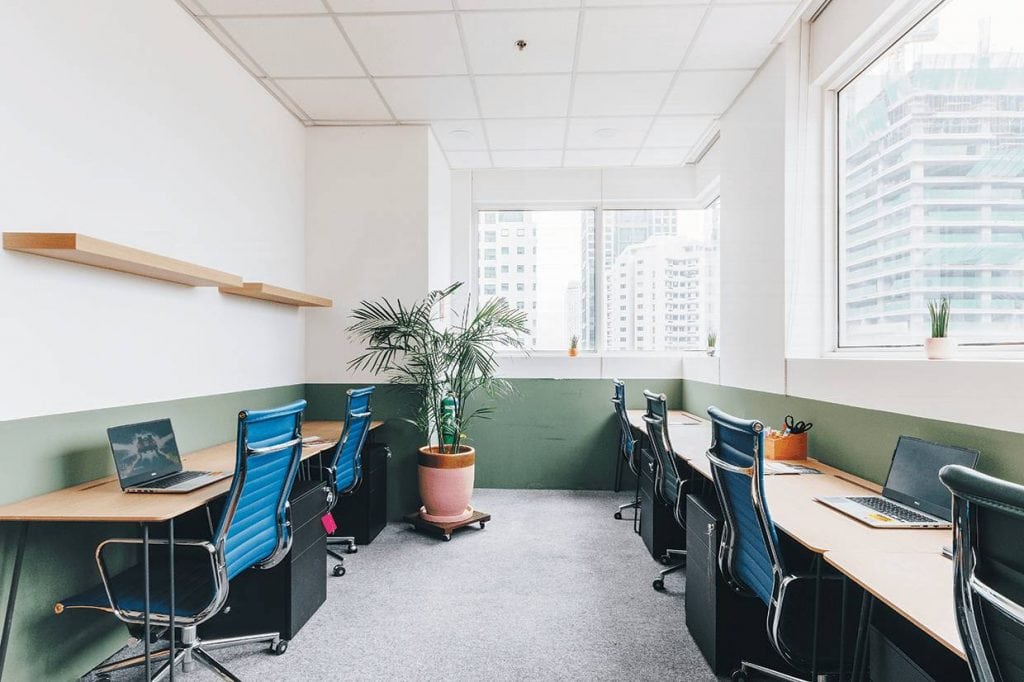Flexible workspaces are likely to play a crucial role in companies’ real estate diversification strategies post-COVID-19.
The popularity of these spaces is thriving especially as firms implement split operations. With opportunities for greater take up, developers should be quick in capturing demand from outsourcing as well as traditional occupants.
The availability of high-quality, new office spaces also bodes well for further expansion of flexible workspace supply within and outside Metro Manila.
Because of new ways of working, it is now crucial for building owners to have a flexible workspace provider in their buildings to capture new office space requirements. Given all the uncertainties, flexibility will be the name of the game.
As hybrid work gains traction, flexible work has become the focus of multinational companies.

Flexible workspaces
Occupiers should revisit their short- and long-term growth projections to properly assess their real estate needs and take advantage of the flexible work solutions as an interim alternative.
Colliers Philippines encourages tenants still on a wait-and-see and with short-term lease plans to consider flexible workspaces. Companies based in Metro Manila should explore buildings in Fort Bonifacio, Makati CBD, and Ortigas Center that offer new and quality flexible workspaces at attractive rates.

In our view, landlords should explore partnerships with flexible workspace operators or launch their own brands. Landlords in key metropolitan areas such as Clark, Cebu, Davao, and Iloilo should also capture flexible workspace take-up.
Tenants should revisit their business continuity plans and consider integrating flexible workspaces into their hybrid work arrangements. Flexible workspace operators may consider occupying space in transit-oriented retail projects and partner with in-mall retailers to add value to their services and lure more consumers to take-up flexible workspaces.
Rising demand for flexible workspaces
Metro Manila’s flexible workspace stock as of the end of Q3 2022 reached 220,200 square meters. This represents about two percent of the total leasable office space in the capital region.
Metro Manila’s flexible workspace stock is likely to grow by about 10 percent in the next 12 months. The availability of high-quality office towers, complemented by attractive lease rates should make these sites viable for flexible workspace operators.

Several high-quality, green and sustainable buildings are in the pipeline, which are ideal locations for new flexible workspaces. We see flexible workspace supply rising in Metro Manila and key areas such as Cebu, Davao and Pampanga as landlords take advantage of greater demand due in part to firms’ strategy of diversifying their real estate portfolio.

Colliers sees take-up for flexible workspaces to be driven by traditional occupiers engaged in construction, architecture, logistics, fintech as well as startup companies.
Outsourcing firms with immediate office space requirements should also consider plug-and-play or fitted offices. Flexible workspaces are popular among companies weighing office space expansion plans in the near term.
Colliers believes that regardless of industry, flexible workspaces are a feasible alternative for companies seeking short-term leases and looking to rightsize operations.
Recommendations
Integrate flexible workspaces into real estate strategies
Colliers Philippines believes that flexible workspaces can play a pivotal role in various tenants’ real estate strategies.
In our view, occupants should consider implementing a diversified office space portfolio, i.e. while they rationalize traditional office space occupied, they should also look at occupying flexible workspaces especially those near the residential areas of their employees.
Establish microsites in provincial areas and key Metro Manila sites
Colliers encourages landlords to consider developing more flexible workspaces in key sites outside of Metro Manila such as Cebu, Iloilo, Davao, Cagayan de Oro, Pampanga and Dumaguete as these locations have relatively low flexible workspace stock and vacancy compared to Metro Manila.
Landlords with existing flexible workspaces in the capital region should consider Quezon City, Bay Area and Fort Bonifacio for their expansion plans given the queries for flexible workspaces in these submarkets and as firms implement their respective hub-and-spoke models.
Developers to launch their own co-working brands
Prior to COVID-19, developers have been launching their own flexible workspace brands to cater to traditional and outsourcing firms with small and immediate office space requirements.
Ayala Land has Clock In, Robinsons Land has launched Work.Able, while Vista Land has created Global Spaces.
Boutique developers may consider launching their own brands or collaborating with existing and known foreign co-working brands.
The flexible workspace is designed and built by the office landlord, while the operator is in charge of marketing and leasing, with rental income shared between them.
For instance, Common Ground and IWG have formed partnerships with the Eco Group and Damosa Land to establish flexible workspaces in their office buildings. This enables both the landlord and operator to attract large occupiers and ensure profitability and tenure.
Integrating flexible workspaces as part of firms’ BCP
The COVID-19 and the occurrence of natural disasters such as typhoons and earthquakes have accelerated the need for occupiers to revisit their business continuity plans (BCP). Colliers encourages occupiers to integrate flexible or hybrid working into their BCPs. We saw the need for this especially after the damage brought by Typhoon Odette in Cebu and other parts of Visayas region in December 2021.
Flexible workspace in malls and/or near transit-oriented developments
From 2022 to 2024, about 60 percent of the new supply that will likely be completed in Metro Manila are regional to super-regional malls with gross leasable area (GLA) of 50,000 sq metres and above (538,000 sq feet and above).
Colliers encourages flexible workspace operators to consider occupying space especially in transit-oriented mall developments especially now that footfall is reverting to pre-covid levels. Operators may also partner with retail establishments such as gyms, restaurants and cinemas to add value to their services.
Supply and demand to rise
In Metro Manila, most flexible workspaces are located in central business districts (CBDs) such as Fort Bonifacio, Ortigas CBD and Makati CBD due to their accessibility as well as presence of high-quality buildings. As of the end of Q3 2022, Fort Bonifacio recorded the highest number of seats at 15,700 followed by Makati CBD and Ortigas CBD.
In absolute figures, Fort Bonifacio led with a flexible workspace stock of 82,400 sq metres (886,600 sq feet). Colliers has received increasing inquiries for flexible workspaces as firms implement return-to-office due to easing Covid restrictions. Landlords are also exploring the viability of securing flexible workspace providers in their spaces to capture smaller seat requirements from potential occupiers.
Over the next 12 months, we are likely to see the delivery of new flexible workspaces in Ortigas CBD, Makati CBD, Alabang, Bay Area and Quezon City with the opening of Regus, The Executive Centre, Greatwork, KMC Solutions and Work.Able facilities.
There’s no doubt that the popularity of flexible workspaces is rising. These office space solutions will definitely be a crucial part of landlords’ and tenants’ expansion strategies beyond 2023.
